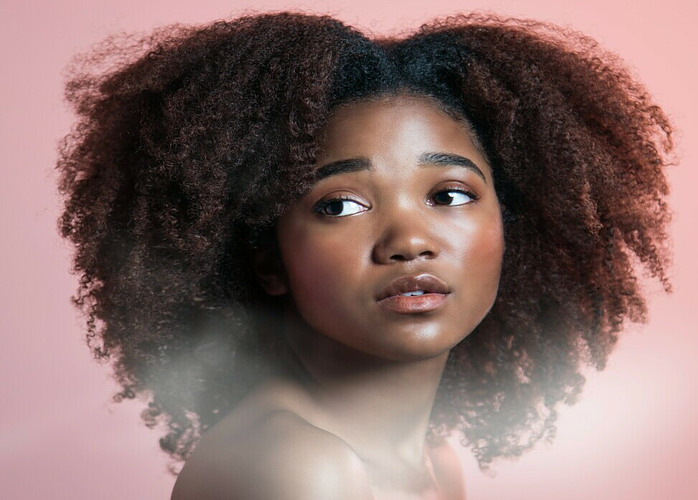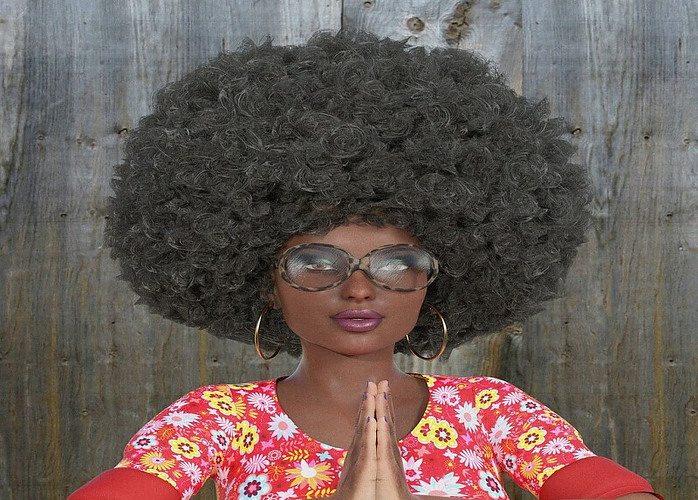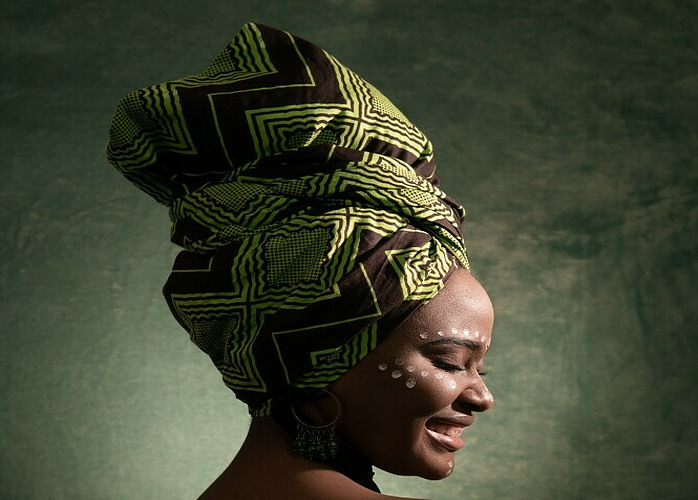Embracing the Beauty of Afro Hair: Understanding Your Curls
Introduction to Afro hair: Diversity of textures and unique character
Afro-textured hair, often referred to as “afro hair,” is incredibly diverse and comes in various textures, patterns, and styles. Here are some key aspects of the diversity of afro hair:
- Texture: Afro hair can have a wide range of textures, from tightly coiled to loosely curled. The classification system commonly used to describe the texture of afro hair is the Andre Walker Hair Typing System, which ranges from Type 3 (curly) to Type 4 (coily/kinky). Within these categories, there’s further diversity in curl patterns, density, and thickness.

- Density: Afro hair can vary in density, referring to the number of strands on one’s head. Some individuals have thick and dense hair, while others may have finer strands.
- Porosity: This refers to how well hair holds and retains moisture. Afro hair often has higher porosity, making it prone to dryness. Understanding porosity helps in selecting appropriate hair care products and routines.
- Styles: The versatility of afro-textured hair allows for numerous styling options, including braids, twists, locs, bantu knots, afros, and more. These styles not only showcase the diversity of afro hair but also represent cultural traditions and personal expression.
- Challenges and Care: Managing afro hair often requires specific care routines due to its unique characteristics. Regular moisturizing, protective styling, and gentle handling are essential. There’s also a growing movement toward embracing natural hair and advocating for products and practices that cater to its needs.
- Cultural Significance: Afro hair carries deep cultural significance within various communities worldwide. It’s a reflection of identity, history, and heritage, playing a crucial role in cultural expression, traditions, and individual style.
- Representation: Historically, mainstream media has not always represented the full diversity and beauty of afro hair. However, there has been a positive shift toward embracing natural hair and celebrating its diversity in recent years, leading to increased representation and appreciation.
Overall, the diversity of afro hair is vast and beautiful, encompassing a wide spectrum of textures, styles, and cultural significance, contributing to its rich heritage and individuality.

The science behind Afro hair: How its structure affects maintenance needs
The structure of afro-textured hair significantly influences its maintenance needs. Several key characteristics of afro hair, such as its texture, porosity, and coil pattern, impact how it should be cared for and maintained:
- Texture and Curl Pattern: Afro hair often has a tight curl pattern, which can make it more prone to tangling and breakage. The bends and twists in the strands make it challenging for natural oils from the scalp to travel down the hair shaft, resulting in drier hair. However, this depends on the porosity of the afro hair texture. Different curl patterns may require varied care routines, with some needing more moisture and others needing specific styling techniques to prevent tangling.
- Porosity: Afro hair tends to have higher porosity, meaning it can absorb and lose moisture more quickly. High porosity hair might benefit from more frequent deep conditioning and moisturizing treatments to maintain adequate hydration levels.
- Dryness: Due to its structure and reduced natural oil distribution along the hair shaft, afro-textured hair often faces challenges with dryness. This makes moisture retention a critical aspect of maintenance. Using hydrating shampoos, conditioners, and oils that penetrate the hair shaft can help combat dryness.
- Shrinkage: Afro hair can experience significant shrinkage, meaning that its length may not be immediately apparent due to the coils and curls. Understanding how to stretch the hair to its full length without causing damage is essential for styling and maintenance.
- Breakage and Damage: The bends and twists in afro-textured hair can make it more prone to breakage, especially if not handled gently. Detangling methods, protective styling, and using appropriate tools (like wide-toothed combs) are crucial to minimize damage.
- Scalp Health: Maintaining a healthy scalp is vital for healthy hair growth. Due to the nature of tightly coiled hair, keeping the scalp clean, moisturized, and free from product buildup is important to avoid issues like dandruff or scalp irritation.
- Styling Techniques: Certain styling methods, such as braiding, twisting, or using heat tools, can impact the health of afro hair. Protective styling, low-manipulation styles, and minimizing heat usage can help maintain hair health.
Understanding these structural characteristics of afro-textured hair is crucial for developing a personalized maintenance routine that caters to its unique needs, promoting healthy growth, moisture retention, and overall hair strength.

Why nurturing Afro hair is essential for both health and self-expression
- Hair Health: Proper care and maintenance of afro-textured hair are crucial for its overall health. This hair type tends to be more prone to dryness and breakage due to its unique structure. Nurturing afro hair involves using appropriate products, gentle handling, and suitable styling techniques to maintain its moisture, strength, and integrity.
- Self-Confidence and Identity: Hair plays a significant role in self-expression and cultural identity for many individuals with afro-textured hair. Embracing and nurturing natural hair can contribute to a sense of pride, confidence, and connection to one’s cultural heritage and identity.
- Cultural Significance: Afro hair holds deep cultural significance within various communities worldwide. The way individuals choose to style and care for their hair often reflects their cultural background, traditions, and personal identity. Nurturing and celebrating afro-textured hair helps preserve cultural heritage and traditions.
- Versatility and Creativity: Afro-textured hair is incredibly versatile and offers a wide range of styling options, from afros to braids, twists, locs, and more. Nurturing this hair type allows individuals to explore various styles and express their creativity, showcasing the diversity and beauty of afro hair.
- Community and Representation: The movement toward embracing natural hair has led to increased representation and visibility of diverse hair textures in media, fashion, and entertainment. Nurturing afro hair supports this positive representation, fostering a sense of community and empowerment among individuals with similar hair textures.
- Education and Empowerment: Learning how to properly care for afro-textured hair promotes education and empowerment within communities. Understanding the unique needs of this hair type helps individuals make informed choices about products, styling techniques, and maintenance routines, leading to healthier, stronger hair.
In essence, nurturing afro-textured hair is not only about maintaining its health but also embracing cultural identity, promoting self-expression, and celebrating diversity. It fosters a sense of pride, confidence, and empowerment within communities while highlighting the beauty and versatility of afro hair.
Dispelling myths and embracing the versatility of Afro hair
Dispelling myths about afro-textured hair and embracing its versatility is crucial in promoting understanding, appreciation, and acceptance of this diverse hair type. Here are some common myths about afro hair and the realities that showcase its versatility:
Myth 1: Afro hair doesn’t grow long.
Reality: Afro hair grows at a similar rate to other hair types. However, due to its tight coil pattern, shrinkage often masks its true length. With proper care, afro-textured hair can achieve impressive lengths.
Myth 2: Afro hair is unmanageable and difficult to style.
Reality: Afro hair is incredibly versatile and can be styled in various ways. There’s a wide range of styling options, including braids, twists, bantu knots, afros, and more. Understanding its unique characteristics is key to effectively managing and styling it.
Myth 3: Afro hair is inherently unprofessional.
Reality: This myth stems from biases and misconceptions about natural hair. Afro hair, like any other hair type, can be styled professionally. The acceptance of natural hair in professional settings is growing, advocating for inclusivity and diversity.
Myth 4: Afro hair is always coarse and rough.
Reality: Afro-textured hair comes in different textures, from fine to coarse, and varies in density and curl pattern. Some strands might feel coarse, while others may be fine and soft. Moisture, proper care, and suitable products can improve texture and manageability.
Myth 5: Afro hair doesn’t require as much care as other hair types.
Reality: Afro hair often requires specific care routines due to its unique characteristics. Proper moisturization, gentle handling, and protective styling are essential to maintain its health and prevent breakage.
Myth 6: Chemical treatments are necessary for manageability.
Reality: Chemical treatments like relaxers or texturizers have been used to straighten afro hair, but they can cause damage and alter the hair’s natural texture. Embracing natural hair and adopting suitable care practices can enhance manageability without resorting to chemical treatments.
Myth 7: Afro hair is not versatile in styling options.
Reality: Afro-textured hair is incredibly versatile and offers numerous styling options, from protective styles to various lengths and textures. It can be braided, twisted, worn in a frohawk, styled in elegant updos, or left free in its natural state.
Embracing the versatility of afro-textured hair involves challenging stereotypes, promoting education, and celebrating its beauty in all its forms. By debunking myths and embracing the diversity of afro hair, individuals can cultivate a greater appreciation for this unique and beautiful hair type.

The importance of hydration and nourishment: Identifying key products
Hydration and nourishment are vital for maintaining the health, strength, and vibrancy of afro-textured hair. Identifying key products that effectively provide moisture and nourishment is essential for a successful hair care routine. Here are some products that can help in hydrating and nourishing afro hair:
- Moisturizing Shampoos: Look for sulfate-free shampoos that gently cleanse without stripping natural oils. Moisturizing shampoos help retain moisture in the hair while cleansing the scalp.
- Conditioners: Deep conditioners and leave-in conditioners are crucial for afro hair. Deep conditioning treatments provide intense hydration and nourishment, while leave-in conditioners help maintain moisture levels between washes.
- Hair Masks and Treatments: Using occasional hair masks or treatments can provide an extra boost of hydration and nourishment. Look for products containing natural oils (like coconut oil, shea butter, argan oil) and ingredients like honey or aloe vera for their moisturizing properties.
- Natural Oils: Natural oils such as coconut oil, jojoba oil, olive oil, and argan oil are beneficial for sealing moisture into the hair, preventing moisture loss, and providing essential nutrients.
- Moisturizing Creams and Lotions: Creams and lotions specifically formulated for afro-textured hair can help maintain moisture and enhance manageability. They often contain ingredients like shea butter or glycerin to hydrate and nourish the hair.
- Water-Based Products: Products with water as the first ingredient are excellent for adding moisture to the hair. Spritzing the hair with a water-based leave-in conditioner can revitalize curls and maintain hydration.
- Scalp Oils or Serums: Nourishing the scalp is crucial for healthy hair growth. Using scalp oils or serums containing ingredients like tea tree oil or peppermint oil can promote a healthy scalp environment.
- Protective Styling Products: When wearing protective styles like braids or twists, using products specifically designed for these styles can help maintain moisture and protect the hair from damage.
- Clarifying Shampoos: Occasionally using a clarifying shampoo helps remove product buildup, allowing other products to penetrate the hair shaft more effectively for better hydration.
- Heat Protectants: If using heat styling tools, using a heat protectant is essential to shield the hair from heat damage while locking in moisture.
It’s important to note that different individuals may respond differently to products, so it’s beneficial to experiment with various products to find the ones that work best for your hair’s unique needs. Additionally, maintaining a consistent hair care routine that includes hydration and nourishment is key to promoting healthy and beautiful afro-textured hair. Do you have any products that you have identified that are suitable to your hair type? Do you find that natural products work better?

Leave a Reply